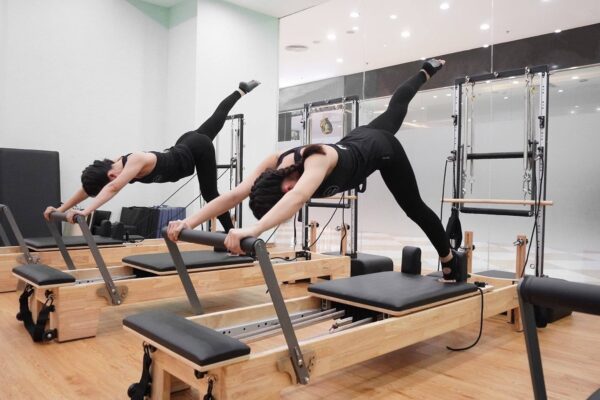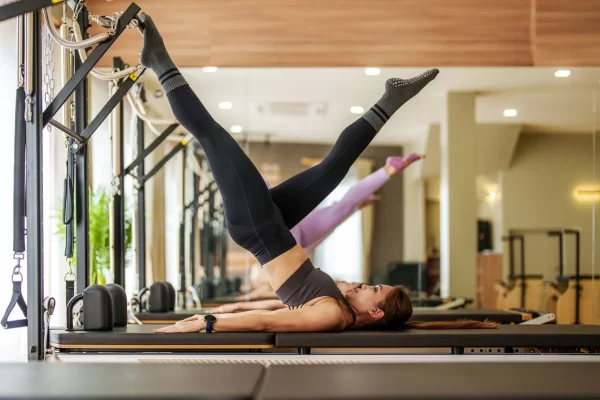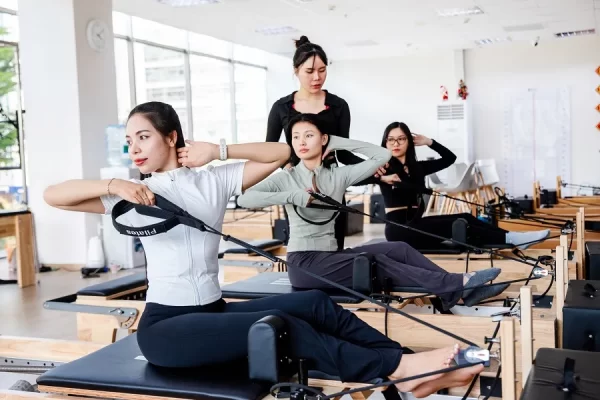Fitness – A Comprehensive Guide for Beginners
18/03/2025Fitness not only helps you achieve a toned body but also improves health, boosts energy, and enhances mental well-being. If you are looking to start a healthy lifestyle but are unsure how to begin, this article will provide you with a detailed guide to embark on your journey of self-improvement!
What is Fitness?
Imagine waking up every morning feeling full of energy, with a flexible body and a refreshed mind. Physical training is the key to unlocking this lifestyle. But what exactly is fitness?
According to the dictionary, the term refers to a person who has a well-balanced physique, good health, and a healthy lifestyle. Simply put, it is a form of physical training that helps individuals improve their bodies, maintain health, and achieve a balanced, toned physique. More importantly, it cultivates endurance, discipline, and fosters a healthy lifestyle both inside and out.
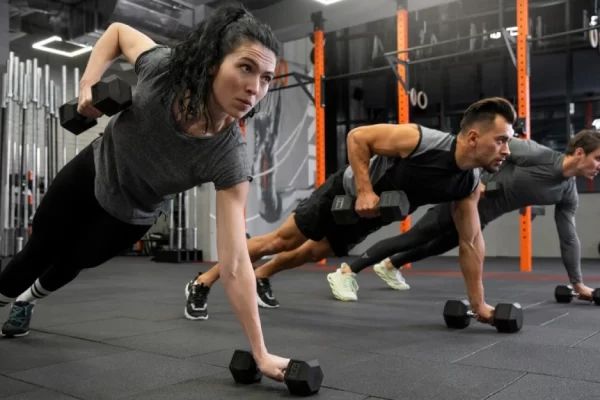
So, if you are looking for a way to love your body more, start your journey toward a healthier lifestyle and improved physical well-being today.
Who Should Engage in Fitness Training?
The simple answer is: everyone! Anyone can engage in physical activities. This practice is not limited to athletes or young individuals; it is suitable for all ages, genders, and occupations, including:
- Office workers:Those who sit for long hours and want to improve their health, prevent back pain, and reduce neck and shoulder strain.
- Postpartum mothers:Women looking to regain their shape and boost confidence.
- Middle-aged and elderly individuals:Those who wish to maintain bone health and flexibility.
- Beginners in fitness:Individuals who aim for a balanced, well-proportioned, and aesthetic body.
- People with health issues:Those who need exercise to improve their posture or overall physical condition.
Core Elements of Fitness
Cardiovascular Health – Cardio
The cardiovascular system plays a crucial role in delivering oxygen and nutrients to every cell, ensuring optimal bodily function. Therefore, improving cardiovascular health is essential in fitness training.
Cardio exercises such as running, jumping rope, cycling, and swimming enhance cardiovascular strength, boost circulation, and improve the heart’s pumping efficiency.
Training your cardiovascular system helps raise your heart rate limit to a new, safe threshold that your body can endure. As your body gradually adapts, you will develop better stamina, not only for workouts but also for handling everyday pressures.
Muscle Strength and Endurance
Muscle strength and endurance are two vital aspects that determine your fitness level. While muscle strength reflects the maximum weight you can lift, endurance indicates the number of repetitions you can perform without exhaustion.
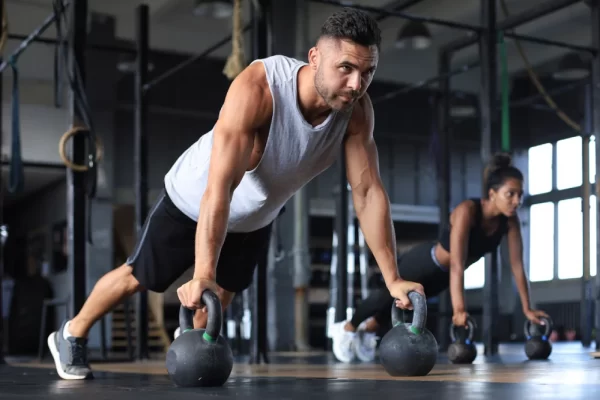
Both aspects are essential in fitness training, allowing you to build a strong, flexible, and toned body.
Flexibility and Balance
Flexibility and balance not only improve movement efficiency but also help prevent injuries and enhance workout performance. These abilities are determined by the range of motion of joints and muscles, as well as the ability to maintain stability during challenging movements.
Activities such as Pilates, Yoga, dancing, or stretching exercises like knee bends, muscle stretches, and one-leg stands can significantly enhance flexibility. These exercises also improve coordination between core muscle groups and the nervous system. With regular practice, you will notice significant improvements in body control, reduced joint pain, better blood circulation, and a more upright posture in daily life.
A flexible and well-balanced body not only improves workout efficiency but also makes movements feel effortless and comfortable.
Speed Training
Speed is not just about moving quickly from point A to point B; it is also a crucial factor in enhancing reflexes and agility in various situations. Whether you are running, playing sports, or reacting to daily challenges, good speed helps you handle everything more efficiently.
To improve speed, focus on specialized exercises such as sprinting, jumping, quick reflex drills, and core muscle training. These workouts not only increase agility but also enhance movement control, making you more responsive both in training and in unexpected real-life scenarios.
Nutrition and Body Composition
Not everyone with the same weight has the same body shape. A person who engages in fitness training and has a high muscle mass will appear more toned and fit than someone with excess fat. Achieving this depends not only on exercise but also on maintaining a proper diet and nutrition plan.
To reach your ideal body composition, combine workouts with a scientifically balanced diet: consume enough protein to nourish muscles, provide essential vitamins and minerals to boost immunity, and maintain proper hydration for optimal bodily functions.
Additionally, getting enough sleep and avoiding harmful foods contribute to better health, youthful skin, and higher energy levels. A well-balanced body is not just about aesthetics but also reflects overall health and well-being.
Effective Training Methods
Pilates
Pilates originated in the early 20th century and was named after its creator, Joseph Pilates. This discipline combines body control, breathing, and fluid movements to enhance muscle strength, improve flexibility, and maintain balance.
Unlike high-intensity workouts, Pilates focuses on activating the core muscle group. As a result, muscles do not bulk up but remain firm, improving posture and reducing the risk of injury.

Pilates is suitable for all ages, especially office workers, those seeking to improve posture, or anyone looking for a gentle yet effective workout. Whether practiced on a mat or using specialized equipment, Pilates offers numerous benefits, such as:
- Strengthening the core muscles.
- Improving and correcting posture issues like hunchback, bowlegs, or forward head posture.
- Enhancing overall health, reducing back, neck, and shoulder pain.
- Preventing injuries from sports or daily activities.
- Regulating the nervous system, promoting mental relaxation, and reducing stress and anxiety.
- Strengthening bones and increasing flexibility and agility.
Today, Pilates has evolved into various forms, including Classic Pilates, Reformer Pilates, Mat Pilates, Clinical Pilates, and Contemporary Pilates.
Gym
Gym training is a physical fitness method that enhances body shape and overall health. It combines cardio exercises for fat burning, weight training for muscle development, and proper nutrition for optimal results.

Going to the gym not only helps achieve a toned and strong body but also provides several key benefits:
- Boosting overall health and strengthening immunity.
- Aiding in weight loss and maintaining a fit physique.
- Strengthening bones and improving muscle flexibility while reducing the risk of injury.
- Increasing endurance, improving mental well-being, and reducing stress.
Yoga
Yoga is a sport that integrates physical movement and mental discipline, helping individuals achieve inner balance. Originating in India thousands of years ago, Yoga is not just a series of exercises but a journey connecting the body, breath, and mind.
Through practicing postures (Asana) combined with breathing techniques (Pranayama), Yoga enhances flexibility, improves endurance, and maintains balance. Moreover, it promotes relaxation, reduces stress, and improves sleep quality.
Yoga is accessible to people of all ages and fitness levels, making it a great way to enhance both physical and mental health.
Barre
Barre is a workout method inspired by ballet, Pilates, and Yoga, designed to improve body shape, endurance, and flexibility. With precise yet graceful movements, Barre helps develop toned muscles while maintaining elegance and fluidity.
During Barre sessions, practitioners use a bar for balance support while performing exercises targeting the core muscles, such as the abdomen, back, and legs. The combination of rhythmic movements and music reduces stress, promotes relaxation, and enhances muscle strength and body control.
Zumba
Zumba is a fitness dance program set to energetic Latin music, creating an exciting workout experience. The movements in Zumba are simple, easy to remember, and suitable for all ages and fitness levels, from beginners to those looking to enhance their physical activity.
Developed in the 1990s by Colombian dancer Alberto “Beto” Perez, Zumba emphasizes dance elements rather than traditional exercises. Its combination of fast, powerful rhythms and dynamic movements helps burn significant calories while maintaining health. This leads to a well-balanced, toned body, improved endurance, and flexibility, aiding in weight loss and body shaping.
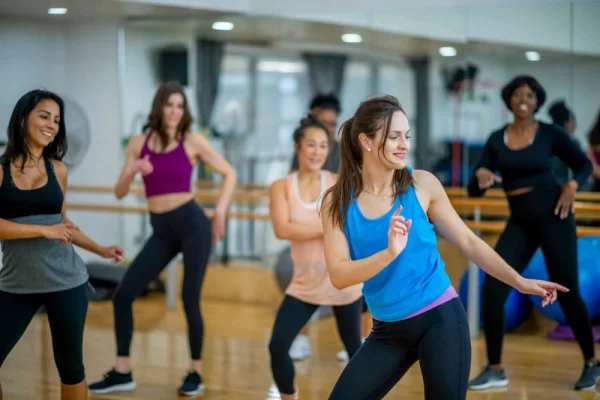
Beyond physical benefits, Zumba also relieves stress, boosts mood, and increases stamina. It fosters a sense of joy and energy, encouraging consistent participation and a love for daily exercise.
Aerobics
Aerobics, also known as aerobic exercise, combines full-body movements with lively music to burn energy and improve health. This workout requires coordinated movements of the arms, legs, hips, and back following guided instructions, enhancing endurance and effectively reducing body fat.
Due to its flexibility and suitability for various age groups, aerobics is particularly popular among middle-aged women, seniors, and those looking to regain their figure after childbirth. These exercises not only promote muscle toning but also enhance blood circulation, improve cardiovascular health, and reduce stress.
Unlike other workout methods, aerobic exercise does not require complex equipment. With just a spacious area and some music, you can start an energizing workout session.
Calisthenics
Calisthenics is a workout method that develops strength, flexibility, and endurance using bodyweight exercises such as running, jumping, push-ups, pull-ups, and squats. What sets Calisthenics apart is its reliance on body weight instead of gym equipment, making it an increasingly popular fitness choice due to its flexibility and effectiveness.
These exercises enhance endurance, build muscle, and improve body control through natural movements like lifting, pulling, pushing, and balancing. As a result, practitioners develop a toned physique, improved agility, coordination, and mental resilience.
With the right space and determination, you can effectively train at home without needing a gym membership.
Benefits of Fitness Training
Physical training activities are becoming increasingly popular and favored by many due to the health, mental, and overall quality-of-life benefits they provide, such as:
Improved Health
Through consistent training, you will undoubtedly notice significant improvements in your health. Exercise enhances circulation, allowing blood to flow more efficiently and oxygen to reach organs throughout the body. This improves cardiovascular function, increases endurance, and reduces the risk of heart disease and high blood pressure.
Additionally, regular exercise strengthens joints and bones, reducing the risk of osteoporosis and spinal issues. A healthy body provides you with abundant energy to fully enjoy life.
A Leaner and More Flexible Body
Engaging in physical activities not only helps with weight loss but also promotes a toned and well-proportioned physique. By combining cardio workouts with strength training, excess fat is effectively burned while muscle groups are developed, resulting in a slimmer and more balanced appearance.

Furthermore, exercise enhances body flexibility. Stretching routines, Pilates, and endurance-based movements improve muscle elasticity, reducing stiffness and soreness after long workdays.
Disease Prevention
Beyond aesthetic benefits, improving physical health serves as a “natural medicine” that helps prevent various diseases. Regular exercise strengthens the immune system, reducing the risk of conditions such as diabetes, obesity, hypertension, and cardiovascular problems.
Moreover, workouts help regulate hormones and enhance metabolism, which is particularly beneficial for individuals who often feel fatigued or lack vitality.
Stress Reduction
Modern life is full of pressures that can lead to stress and exhaustion. Fitness training is an excellent way to relieve stress and boost happiness. During exercise, the body releases endorphins—hormones that improve mood, reduce anxiety, and promote feelings of well-being.
Additionally, focusing on workouts allows you to temporarily set aside daily worries, significantly enhancing mental health.
Better Appetite and Sleep
After a workout, your appetite naturally increases. Exercise stimulates digestion, enabling the body to absorb nutrients more efficiently—especially beneficial for those with eating difficulties or poor nutrient absorption.
Exercise also improves sleep quality. Physical activity promotes relaxation, making it easier to fall asleep and enjoy deeper rest. A good night’s sleep aids body recovery, boosts energy, and maintains mental stability.
Common Mistakes in Fitness Training
While fitness training offers numerous benefits, improper techniques or habits may lead to injuries or unsatisfactory results. Below are some common mistakes people make during workouts:
Skipping Warm-ups
Many overlook warm-up routines, considering them unnecessary. However, warming up prepares the body for physical exertion, activates muscles, and minimizes injury risks. Without proper warm-ups, you may experience muscle strain, cramps, or soreness after exercising.
Incorrect Form
Poor posture and improper techniques not only decrease workout efficiency but also pose serious risks, particularly to the spine, knees, and shoulders. Common mistakes include lifting excessively heavy weights, improper movement execution, or lack of movement control, leading to avoidable injuries.

Focusing Only on One Muscle Group
Some individuals concentrate solely on one muscle group—such as the abs, arms, or chest—while neglecting others. This leads to body imbalance, reduced training effectiveness, and an increased risk of muscle imbalances and injuries.
Inadequate Rest and Recovery
Many believe that working out more frequently yields better results. However, muscles require sufficient rest for proper recovery and growth. Overtraining can lead to exhaustion, weakened immunity, and increased injury risk.
Neglecting Nutrition
Exercise without a proper diet will not produce the desired results. Insufficient food intake leads to low energy levels, while uncontrolled eating may result in excess fat or unhealthy weight gain.
Lack of Patience
When immediate results are not visible, people often lose motivation and quit. In reality, fitness progress takes time and requires consistency. To achieve lasting results, patience and perseverance are essential.
How to Start Your Fitness Journey Effectively?
Without a clear plan, you may waste time or fail to reach your goals. Here are key steps to start your fitness journey effectively:
Set Clear Goals
Before beginning, define your purpose for training. Each person has different objectives, such as:
- Losing weight, burning fat, and achieving a toned body.
- Gaining muscle, enhancing strength, and improving physique.
- Boosting overall health, endurance, and flexibility.
- Reducing stress and maintaining a positive mindset for a better quality of life.
Setting realistic and measurable goals—such as losing 5kg or exercising three times per week—helps create a structured fitness plan and sustains long-term motivation.
Choose the Right Workout Program
Fitness encompasses various training styles, and not every method suits everyone. Different workouts align with specific goals and preferences, such as Pilates, Gym, or Yoga. Experiment with different routines to find one that best fits your lifestyle.

Develop a Structured Training Plan
Once you’ve determined your goals and preferred workout, the next step is to create a well-balanced training schedule.
If you’re a beginner, avoid jumping into intense workouts immediately. Start with a structured plan, training three to four times per week for 30-45 minutes per session, allowing your body to adapt gradually.
Monitoring your progress weekly is crucial to track improvements. If no noticeable progress is observed after one or two months, adjust your training plan accordingly.
Key Tips for Effective Fitness Training
To maximize fitness results, dedication alone is not enough—you must also maintain healthy habits. Below are essential tips to optimize your training and achieve goals more efficiently:
- Get enough sleep: Lack of sleep causes fatigue, reduces focus, and negatively impacts training performance.
- Stay hydrated: Water supports nutrient transport, sustains training efficiency, and accelerates muscle recovery. Drink at least 2-3 liters per day, depending on workout intensity.
- Train consistently: Success comes from persistence. A well-toned body is not achieved overnight but through long-term commitment.
- Listen to your body: Overtraining can lead to injuries and counterproductive results. Adjust intensity levels based on your physical condition to ensure safety and effectiveness.
Fitness is not just an exercise routine—it’s a journey toward a healthier and more positive lifestyle. Don’t wait for tomorrow; find a workout that suits you and start today to become the best version of yourself!

